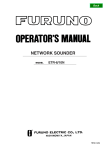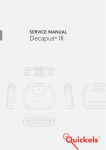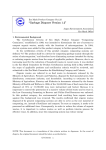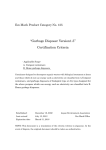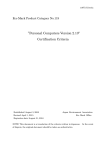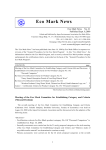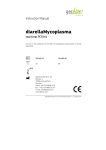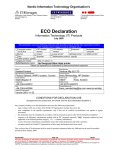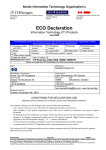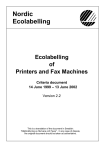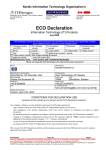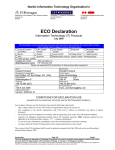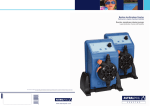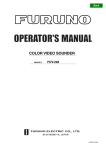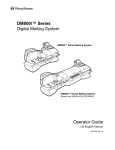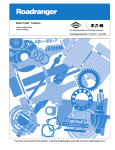Download Draft for Certification Criteria of Eco Mark Product Category
Transcript
Established : October 1, 2001 Eco Mark Product Category No.122 “ Printers” Printers” Japan Environment Association Eco Mark Office 1 . Environmental Background In recent years, along with the worldwide dissemination of personal computers, the annual output of printers in Japan increased in an accelerated fashion from about 25 million units in 1996 to 29 million in 1997 and further to 32 million in 1998. Japanese manufacturers’ share in the world market is particularly large as will be described in more detail below. There already is an Eco Mark product category applicable to printers, Category No. 53 covering “Low-Waste Printers for Business Machines.” Printers requiring replacement of only expendables, such as printing toner, or allowing repeated use of cartridges to reduce wastes are recognized as Category No. 53 printers. However, merely reducing expendable wastes can contribute little to alleviating the environmental load, and it is strongly urged to reduce the overall environmental load of printers, whose use is now dramatically expanding. This calls for consideration of the total lifetime of each printer from the consumption of raw materials till their recycling. For printers, standardization is already in place with ecolabels prescribed by Germany, Canada and five Scandinavian countries. In Japan, “specific procurement items” under the Law Concerning the Promotion, Etc. of Procurement of Environmentally Sensitive Goods by the National Government, Etc. which came into force in April 2001 include printers, and the law also specifies certification criteria. The Green Purchasing Network has announced its purchasing guidelines (in November 1996), arousing further interest in the ecologically-conscious choice of printers. From the viewpoint of effective utilization of resources, the amended Law Concerning the Promotion of Effective Utilization of Resources, effective April 2001, took up secondary batteries as “designated reusable products,” and at the same time designated printers as machines using small secondary batteries, designated reusable products. Arrangements are ready for the collection of used secondary batteries from April this year on. NOTE: This document is a translation of the criteria written in Japanese. of dispute, the original document should be taken as authoritative. 1 In the event Japanese-made printers enjoy a dominant share in the world market, about 97% for the wire dot type, 85% for the electrophotographic type and 60% for the ink jet type. Thus, together with copying machines, printers are an international item supplied by Japanese manufacturers to users worldwide. Therefore, it is essential to give due consideration to international conformity in formulating qualification criteria for ecolabels. For “copiers” for which Eco Mark qualification criteria were set forth in November 1999, JEA is making conformity efforts with Nordic White Swan through the GEN (Global Ecolabeling Network), and a similar approach is also likely to be needed for printers in the future. In view of these circumstances, it is considered very meaningful, internationally as well, to discard the existing provisions regarding “Low-Waste Printers for Business Machines” and institute anew a product category covering environmentally-friendly printers. 2. Applicable Products The subject of this new Eco Mark categorization mainly consists of printers commonly used in offices and families and intended for connection to computers. Following the classification by the Japan Electronics and Information Technology Industries Association (JEITA), Terminology for Printer Catalogs, Fourth Edition (in Japanese), the category includes printers of the wire dot, thermo sensitive, ink jet and electro photographic types (see the “Coverage” graphic shown in Fig. 1). It also covers multifunctional machines whose main function is printing. Therefore it does not include ticket vending machines in stations of traffic facilities, order ticket issuing machines to serve people waiting in a queue, cash registers and search equipment for use in medical facilities or public libraries. Printer Impact Printer Matrix type system Wire dot system Non-impact printer Thermo Thermo sensitive Ink jet system Electrophotographic system Electrostatic system Magnetic system Fig. 1 Coverage 2 Coverage of these criteria 3 . Terminology -Printer: -Component of formula: -Plastic: -Polymer: -Homopolymer: -Copolymer: -Polymer alloy (polymer blend): -Reclaimed plastic: -Pre-consumer material: -Post-consumer material: -Reclaimed plastic component: -Reused component: -Back side printing: -Double side printing: -Multi Functional Printer (MFP): A machine having function as its standard features which presuppose connection to a personal computer via a parallel port, USB interface or network interface. It may also perform direct printing via a memory card or some other medium. Any component intentionally added for the purpose of giving a characteristic(s) to the product. Impurities which inevitably come in during the manufacturing process do not fit this definition. A material consisting of one or more polymers and any additive, filler, etc. added for the purpose of giving a characteristic(s). A high molecular material constituting a main constituent of a plastic. A polymer of monomers of a single type. A polymer of monomers of two or more types. A generic term for multiple-component high molecules resulting from the mixture or chemical combination of two or more kinds of high molecules. A polymer blend is a physical mixture of different kinds of high molecules. A plastic consisting of a pre-consumer material and a postconsumer material. A material or a rejected item emerging in the manufacturing process of a product, not to be recycled as a raw material in the same process (plant). A material or a product discarded after being used as a product. A plastic-made component containing any reclaimed plastic. A component used in the past and now in use again. Printing again on a sheet of paper, of which one side is already printed, on the other side with the same machine by putting it into a paper feed tray or otherwise. Automatic printing on both sides of a sheet of paper. A machine having a printing function as one of its standard features plus one or more of copying, scanning or facsimile functions. -Printing speed in For monochrome printers, the number of pages that can be pages per printed per minute as determined according to ISO/IEC minute(PPM): 10561:1999, though for color printers the speed is stated by each manufacturer as there is no standardized criterion. -Large size printer: A printer with a printing function for printing A2 or larger size sheets. -Vital component: An indispensable component for keeping the product functional. -Vital component A vital component for replacement. for repair use: -Recycling: Refers to material recycling only, not to energy recovery (thermal recycling). -Box: External cover -Chassis: A component with the core function of securing the main component of the printer per se. 3 -Large box component: -Battery: -Stack form: A box component of 25 g or more in weight and 200 mm 2 or more in square measure. A primary or secondary battery. A primary battery is no longer used once its charge is exhausted, while a secondary battery can be recharged for repeated use. A continuous long strip of paper for computer print-out use. It may be perforated at regular intervals to facilitate folding into a box shape. 4 . Certification Criteria 4-1.Environmental Criteria 4-1-1.3R Design 1) Printer per se (1) A printer shall satisfy the requirements of the “3R design of the printer per se ” in Attachment 1. (2) The vital components for repair use and expendables shall be kept in stock for at least five years after the manufacture of the relevant product is discontinued. (3) The arrangements for meeting repair needs shall be adequately developed to enable repairs requested by printer users to be accomplished (repair system). The arrangements shall include adequate supply of information on 1) the availability of repair service and 2) the available range of repair service, required length of time, cost and way of access for printer users. (4) One or more kinds of recycled paper with 100% used paper content shall be usable, except for thermo sensitive type printers, and printers supporting continuous paper feeders and large printers. (5) A printer shall be able to reduce the quantity of paper consumption (by double side printing, compressed printing, back side printing or otherwise). (6) An electro photographic or multifunctional printer (PPM > 24) shall be capable of double side printing as either a standard or an optional function. This provision, however, shall not apply to any printer using a stack form. 2) Components using plastic materials (7) A plastic-made large box component shall consist of one homopolymer or copolymer. The use of a polymer blend (polymer alloy) is acceptable. This provision, however, shall not apply to components weighing less than 25 g each. (8) A plastic-made large box component or chassis shall consist of four or fewer kinds of separable polymers or polymer blends. This provision, however, shall not apply to components constituting a component/chassis of less than 25 g. 4 3) Battery (9) A battery fitted to a printer shall be replaceable or removable when it has become exhausted, when the printer is to be repaired or in any other like situation without having to replace the whole printed circuit board or the like on which the battery is mounted (this applies to what falls under any of A through F in Attachment 4). A battery fitted to a substrate or the like whose removal by the printer user shall have a useful life of at least 10 years. (10) The user manual shall contain information on the collection, reuse, recycling or disposal as waste matter of used secondary batteries. 4) Toner cartridge and ink cartridge (11) For toner cartridges (including toner containers) and ink cartridges manufactured or marketed by the applicant, there shall be a system of collection and recycling. (12) Collected toner cartridges (including toner containers) or unusable parts of ink cartridges, shall be processed and/or disposed of in a manner harmonious with the environment. (13) A toner cartridge shall bear a label conforming to the Guidelines on Labeling for Ensuring the Safety of Office Machinery Products of the Japan Business Machine Makers Association. 4-1-2.Chemical Substances 1) Plastic materials (14) No plastic of 25 g or more in weight shall contain polybrominated biphenyl (PBB), polybrominated diphenyl ether (PBDE) or chlorinated paraffin (having a chain of 10 to 13 carbon atoms and a chlorine concentration of 50% or more) added as a formula component. (15) No plastic (including any plastic used for packaging) in any box or box component shall have a halogen-containing polymer added as a formula component, except for organic fluorine additives of no more than 0.5 wt% in content used for improving the physical properties of the plastic or components of less than 25 g in weight. (16) No plastic in any box or box component shall have cadmium or lead added as a formula component. No plastic in any box or box component should have any carcinogenic substance (anything classified by IARC as a carcinogenic substance of Group 1, 2A or 2B), except for titanium yellow, antimony trioxide and carbon black. 2) Battery (17) No battery shall contain cadmium, lead, mercury or any compound thereof added as a formula component. 3) Chlorofluorocarbons, harmful substances, etc. (18) Any plastic packaging material to be used by the applicant shall 5 contain no specified chlorofluorocarbon (CFC) (any of the five CFCs; see Attachment 5). (19) It shall be definitively demonstrated that the final assembly plant or large box components uses any of the specified CFCs (the five CFCs), any other CFC, carbon tetrachloride or trichloroethylene, or discharges any alternative CFC (which refers to HCFC in this context). However, chlorofluorocarbons used for air conditioners shall be excluded, and this only applies to use during the manufacturing stage. It shall also be definitively demonstrated regarding the discharge of harmful substances that the final assembly plant and the manufacturing plant or plants of plastic box components and large box components are observing relevant local environmental laws and regulations, antipollution agreements and the like. It shall be definitively demonstrated that the manufacturing factory of the direct supplier for plastic box components or large box components does not use any of the specified CFCs (the five CFCs) listed on Table 5, any other CFC, carbon tetrachloride or trichloroethylene, or discharge any alternative CFC (which refers to HCFC in this context). However chlorofluorocarbons used for air conditioners shall be excluded, and this only applies to use during the manufacturing stage. A component purchase contract or the like, however, may be substituted for verification by the plant manager of the supplier of plastic box components or large box components to the applicant. 4) Photosensitive unit (20) The photosensitive unit of an electro photographic type printer shall contain no cadmium, lead, mercury or any compound thereof as a formula component. 5) Toner for electro photographic system, ink for ink jet system and ink ribbon for wire dot system (21) As a heavy metal content of toner for electro photographic type printers, ink for ink jet type printers and ink ribbon for wire jet type printers, no cadmium, lead, mercury, hexavalent chrome or any compound thereof can be added as a formula component. (22) Toner for electro photographic type printers, ink for ink jet type printers or ink ribbon for wire jet type printers shall contain none of the substances mentioned in (a) through (d) below as a formula component. (a) Substances for which labeling of the following R numbers is mandatory under Attachment I (List of hazardous substances and preparations) to the EC Council Directive 67/548/EEC regarding the conformity of EU laws, regulations and administrative rules on the classification, packaging and labeling of hazardous substances. 6 R26 (Very toxic if inhaled) R27 (Very toxic in contact with skin) R40 (Possible risk of irreversible effects) R42 (May cause sensitization by inhalation) R45 (May cause cancer) R46 (May cause heritable genetic damage) R49 (May cause cancer if inhaled) R60 (May impair fertility) R62 (Possible risk of impaired fertility) R63 (May cause harm to an unborn child) R64 (May cause harm to breast-fed babies) (b) Substances classified as carcinogenic substances (Groups 1, 2A, 2B) by the International Agency for Research on Cancer (IARC), except carbon black. (c) Substances that necessitate labeling of the whole product with the specified hazard symbol under Attachment II to the EC Council Directive 67/548/EEC regarding the conformity to EU laws, regulations and administrative rules on the classification, packaging and labeling of hazardous substances. (d) Substances that necessitate labeling of the whole product with the specified R43under Attachment III to the EC Council Directive 67/548/EEC regarding the conformity of EU laws, regulations and administrative rules on the classification, packaging and labeling of hazardous substances. (23) An azo colorant (dye or pigment) of toner for electro photographic type printers, ink for ink jet type printers or ink ribbon for wire dot type printers, azo colorants (dyes or pigments) that degenerate into amines as per Table 6 through decomposition of one or more of the azo compounds (in accordance with official test method compilation based on Article 35 of the German law on foods and sundries) shall not be used. 6) Dust, ozone and styrene (24) Dust emissions from an electro photographic printer shall not exceed a concentration of 0.075 mg/m 3 in the case of 2 hours continuous operation in indoor atmosphere. The dust concentration shall be measured under the test conditions specified in the applicable standard of the Japan Business Machine Makers Association (JBMS-66) or in Attachment 3 to Blue Angel RAL-UZ62. This provision, however, shall not apply to printers for printing stacked forms faster than 60 PPM. (25) Ozone emissions from an electro photographic printer shall not exceed a concentration of 0.02 mg/m 3 in indoor atmosphere. The ozone concentration shall be measured under the test conditions specified in the applicable standard of the Japan Business Machine Makers Association (JBMS-66) or in Attachment 4 to Blue Angel RAL-UZ62. This provision, however, shall not apply to printers for printing stacked forms faster 7 than 60 PPM. (26) Styrene emissions from an electro photographic printer shall not exceed a concentration of 0.07 mg/m 3 in indoor atmosphere. The styrene concentration shall be measured under the test conditions specified in the applicable standard of the Japan Business Machine Makers Association (JBMS-66) or in Attachment 5 to Blue Angel RAL-UZ62. This provision, however, shall not apply to printers for printing stacked forms faster than 60 PPM. 4-1-3.Energy Consumption (27) Electric power consumption shall conform to (1) through (4) in Attachment 6 based on the International Energy Star Program (hereinafter referred to as Energy Star). (28) A main power switch shall be provided. Power consumption with the main power switch off shall not exceed 2 W. (29) No function of the printer shall be adversely affected by keeping it unplugged from an A.C. outlet for a relatively long period (at least four weeks) (any loss of timer information including the date and hours is not deemed to be an adverse effect in this context). (30) The user manual provided by the supplier for an electro photographic type printer shall contain information on the maximum power consumption in the operating state. (31) The applicant shall state in the user manual detailed information on the consumption of energy in the mode of “power off” and, if any energy is consumed in this mode, expressly indicate that this energy consumption cannot be avoided unless the printer is unplugged from an A.C. outlet. 4-1-4.Noise (32) Noise shall be measured in the best quality mode in accordance with ISO 7779: 1999 (the Japanese Industrial Standards include an identical standard – JIS X 7779: 2001). On the basis of the actual measurement thereby obtained, the value of the A Designation Characteristic Sound Power Level L WAd under 3.2.5 of ISO 9296: 1988 shall not exceed the applicable value in Attachment 7. 4-1-5.Safety and Electromagnetic Compatibility (33) The printer shall be a product conforming the safety requirements of IEC60950. For example, it shall satisfy the ‘Safety Standards on Data Processing Equipment (JEIDA-37)’ of the Japan Electronics and Information Technology Industries Association or the ‘Standards of Section 2 of the Technological Standard Ordinance on Electric Products (J60950)’ (both conforming to IEC60950). (34) The printer shall be a product satisfying the electromagnetic compatibility requirements of the voluntary regulatory measures of the Voluntary Central Council for Interference by Information Technology 8 (VCCI). 4-1-6.User Manual (35) The user manual provided by the applicant shall be compatible with the Eco Mark Certificate Criteria “Paper Printed Matter”. However, use of hot-melt adhesive shall be approved. What is printed overseas shall be made of used paper and bound in a manner posing no impediment to recycling. 4-1-7.Packaging Materials (36) Any plastic material used for packaging shall be labeled in conformity with JIS K 6899-1: 2000. However, labeling of the material may be dispensed with in conformity to “Measures Concerning Plain Containers and Packaging,” “Measures Concerning Containers and Packaging with Physical Constraints Including Labeling Space, etc.,” “Labeling Requirements and Labeling Method for Multi-layered Containers and Packaging,” “Measures Concerning Packaging Marked with Company Name, Brand Name, etc.” and “Measures Concerning Imported Items” on identification marks in the Report of the Container and Packaging Recycling Subcommittee of the Ministry of International and Trade and Industry (predecessor of the present Ministry of Economy, Trade and Industry) (July 2000). (37) Any packaging material shall be compatible with the Guidelines on the Preparation of Advance Assessment Manuals in Product Designing to Contribute to the Promotion of the use of Recycled Resources, etc.” (July 1994, Waste Matter Disposal and Recycling Subcommittee, Industrial Structure Council). 4-1-8.Conditions of Installation (38) If there is any matter to be specifically stated regarding the conditions of installation, it shall be expressly stated in the user manual. 4-2.Quality criteria None. 5 . Method of Certification of Compatibility with Certification Criteria The applicant (in the case of a raw material, the supplier thereof) shall submit as a seal-bearing document each of the certificates listed in Table 1. A duplicate copy of each certificate shall be acceptable. Compatibility with other certification criteria stated in 4-1 (e.g., “Paper Printed Matter”, “Energy Star” and so forth) shall be deemed to be certified if the relevant item is compatible with the current version of the applicable certification criteria at the time of applying for an Eco Mark. (1) Regarding certification criteria 4-1. (1), submit Attachment 1, “3R design of 9 the printer per se,” properly filled out. (2) Regarding certification criteria 4-1. (2), submit a certificate regarding the minimum stock period for vital components for repair use and expendables. In addition, submit a user manual or the like expressly stating this fact. (3) Regarding certification criteria 4-1. (3), submit a certificate regarding the availability of repair service as requested by the user of the printer. In addition, submit a user manual or the like expressly stating that arrangements are well developed for the purpose (with reference to the processing capacity, particulars of information supply as prescribed by the criteria, etc.). (4) Regarding certification criteria 4-1. (4), submit a certificate that a 100% used paper content is compatible. Also submit a raw material certificate stating the name of the manufacturer of the printing paper to be used, brand name of the product and that the used paper content is 100%. (5) Regarding certification criteria 4-1. (5), describe if there is a function to reduce the quantity of paper consumption provided (for example, by double side printing, compressed printing, back side printing or otherwise). Also submit a user manual or the like expressly stating this fact. (6) Regarding certification criteria 4-1. (6), submit a relevant part of the user manual. (7) Regarding certification criteria 4-1. (7) and (8), describe expressly that these criteria are observed. In addition, submit a list of the plastic materials used (Attachment 3). (8) Regarding certification criteria 4-1. (9), submit a certificate regarding the position where the battery is used, the method of removing it in accordance with Attachment 4 (specify the section sign) and so forth. (9) Regarding certification criteria 4-1. (10) submit a manual regarding the arrangements developed for collection, reuse, recycling or processing and/or disposal (collection system, processing capacity, particulars of processing, etc.). (10) Regarding certification criteria 4-1. (11), submit a description of the mechanism of the recovery system (collection system, processing capacity, particulars of processing, etc.). (11) Regarding certification criteria 4-1. (12), submit a manual regarding the arrangements developed for collection, reuse, recycling or processing and/or disposal (collection system, processing capacity, particulars of processing, etc.). (12) Regarding certification criteria 4-1. (13), submit a certificate that the product is labeled in conformity with the Guidelines on Labeling for Ensuring the Safety of Office Machinery Products. (13) Regarding certification criteria 4-1. (14), make it definitively clear by a component purchase contact or the like that no PBB, PBDE or chlorinated paraffin is added. (14) Regarding certification criteria 4-1. (15), submit a list of the plastic materials used on the form in Attachment 3, expressly stating the names of 10 the manufacturers of the raw materials and whether or not there is the addition of any polymer containing halogen and/or any organic halogen compound. (15) Regarding certification criteria 4-1. (16) and (17), submit a list stating the presence or absence of any relevant substance contained therein. (16) Regarding certification criteria 4-1. (18), submit a certificate issued by the manufacturer of the packaging material, the person responsible for the management of the business establishment or the manager of the plant where the product is assembled to the effect that the plastic packaging material used in the packaging done on the applicant’s responsibility contains no specified CFC. (17) Regarding certification criteria 4-1. (19), submit a certificate issued by the manager of the final assembling plant where the product is manufactured to the effect that relevant local environmental laws, regulations and the like have been observed with no violation for the last five years before the filing of the application. A component purchase contract or the like may be substituted for certification by the plant manager of the supplier of plastic box components or large box components to the applicant. (18) Regarding certification criteria 4-1. (20) through (23), submit a list stating the presence or absence of any relevant substance contained therein. (19) Regarding certification criteria 4-1. (24), submit a certificate that the method of measurement meets the relevant standard in JBMS-66 or Attachment 3 to RAL-UZ62, together with actually measured data. (20) Regarding certification criteria 4-1. (25), submit a certificate that the method of measurement meets the relevant standard in JBMS-66 or Attachment 4 to RAL-UZ62, together with actually measured data. (21) Regarding certification criteria 4-1. (26), submit a certificate that the method of measurement meets the relevant standard in JBMS-66 or Attachment 5 to RAL-UZ62, together with actually measured data. (22) Regarding certification criteria 4-1. (27), submit a certificate (a certificate of compliance with Energy Star program or a report of test results) that states criteria (1) through (4) in Attachment 7 are in conformance. (23) Regarding certification criteria 4-1. (28) and (29), submit a certificate that these requirements are fully met. (24) Regarding certification criteria 4-1. (30), submit a relevant part of the user manual stating the maximum power consumption measured under the applicant’s own conditions. (25) Regarding certification criteria 4-1. (31), submit a relevant part of the user manual. (26) Regarding certification criteria 4-1. (32), conduct measurement in the best quality mode of ISO 7779: 1999, and submit data indicating the value of the A Designation Characteristic Sound Power Level LWAd under 3.2.5 of ISO 9296: 1988. (27) Regarding certification criteria 4-1. (33), submit a certificate that the product satisfies standards in compliance with IEC60950 such as the 11 ‘Standards of Section 2 of the Technological Standard Ordinance on Electric Products (J60950)’ shall be submitted. If submission of such certificate is difficult, a written declaration to confirm that “a certificate will be submitted before concluding a contract to use the Eco-Mark, and if the product does not comply with the IEC60950 standards, the Eco-Mark usage contract will not be concluded” shall be submitted. (28) Regarding certification criteria 4-1. (34), submit a certificate (a copy of written notification confirming that the product complies with the VCCI or the like) that the product is compatible with the voluntary regulatory measures of VCCI. If submission of such a certificate is difficult, a written declaration to confirm that “a written notification confirming that the product complies with the VCCI will be submitted before concluding a contract to use the Eco-Mark, and if the product does not comply with the VCCI, the EcoMark usage contract will not be concluded” shall be submitted. (29) Regarding certification criteria 4-1. (35), submit information material certifying compatibility with the items of the Eco Mark Certificate Criteria “Paper Printed Matter”. Where printing is done overseas, it has to be explained that used paper is employed and no material identified as an inhibitory factor to the recycling of used paper is employed. (30) Regarding certification criteria 4-1. (36), submit a certificate regarding the presence or absence of material labeling. (31) Regarding certification criteria 4-1. (37), explain compatibility with the guidelines; more specifically, 1. Explain that the packaging material is selected in accordance with a packaging material assessment manual prepared in accordance with the guidelines [submit an information material (a list of contents or the like) which reveals the contents of the manual], and 2. state the name(s) of the packaging material(s) used. (32) Regarding certification criteria 4-1. (38), submit a relevant part of the user manual if there is any matter specifically stated regarding the conditions of installation. 6 . Others (1) A product category shall consist of a product model or a series of models. One application may cover a whole series, but each model of the series should be compatible with the relevant criteria. (2) The statement in the lower part of the mark contains the following environmental information. In this case, it shall be a 2-line statement within a rectangular box. The 1st line shat state “Low electricity nd mode: Power consumption xx W”, the 2 line shall state “Recyclable rd “Toner container collection design”, and the 3 line shall state route is established” ( “Ink container collection route is established” shall be stated for ink cartridge cases.) 12 Friendly to the Earth Electric consumption in the low mode Recyclable design XX W Collection route of toner containers established Established : October 1, 2001 Partially Revised: June 6, 2002 These certification criteria for the product category will be reviewed in five years after the date of enactment, and the certification criteria and/or the product category will be revised or abolished. 13 Interpretation Product Certification Criteria for “ Printers” Printers ” Established : October 1, 2001 1 . Environmental Background General Catalog of Printers, ’99, published by the Japan Economic Center, Inc. (in Japanese) was referenced for the trend of the production figures of major printers in Japan. 2 . Applicable Products The limitation of the subject to “mainly printers commonly used in offices and by families” is due to the difficulty of applying uniform standards to such special-purpose printers as those for ticket vending machines in stations of transport facilities, order ticket issuing machines to serve people waiting in a queue, cash registers and search equipment for use in medical facilities or public libraries. Although the standards of Blue Angel and Nordic White Swan apply only to “machinery and equipment used in offices,” the inclusion of printers for family use is expressly stated here because, together with personal computers, the use of printers (especially of the ink jet type) by families is rapidly spreading. The reference to “printers ... intended for connection to computers” is to make clear the exclusion of the above-mentioned special-purpose printers. The printing systems of the different types of printers are based on the Japan Electronics and Information Technology Industries Association (JEITA), Terminology for Printer Catalogs, Fourth Edition (in Japanese) (September 2000). 3. 3 . Terminology <Printer> The term as used herein refers in principle to printers intended for connection to computers as stated above, but in view of the recent increase in printers using a memory card or some other medium on which pictorial information is stored and outputting is done without using a cable in-between, such printers are also covered by the term. <Back side printing> It was pointed out that, for instance, if a sheet of paper already printed on one side is printed on the other side with a different printer, the rollers of the second printer may pick up the ink of the first print on account of a difference in the fixing temperature of toner, and its useful life may be shortened. In view of this problem, for the purpose of this set of criteria, “back side printing” refers only to printing again on a sheet of paper, of which one side is already printed, on the other side with the same machine. <Multi Functional Printer> The multi functional printer is covered by this set of criteria and the Eco Mark Certification Criteria No. 117 for the “Copier.” As the criteria for the 14 “Copier” give no definition of a “multi functional printer,” the coverage of the concept includes such machines other than the “multi functional printer” defined in the criteria for the “Printer.” It is up to the applicant to decide what the main function of a given multi functional printer is. <Chassis> When the box acts as a chassis as well, it shall be handled as a chassis because its function as a structural component takes priority. <Stack form> Criteria for the stack form conform to the Japan Business Machine Makers Association’s standard on the stacked form for the electro photographic nonimpact printer JBMS-31: 1987. 4. Certification Criteria 4-1.Circumstances of the Formulation of Environmental Criteria In setting the criteria, the Table for Selection of Environmental Impact Items at Different Life Stages of Products was referenced, and environmental impacts over the whole lifespan of the product were considered from an environmental perspective. Impact items regarded as particularly important in setting certification criteria were selected, and a qualitative or quantitative criterion was formulated for each of these items. The environmental impact items considered for the product category “Printer” conform to the Table for Selection of Environmental Impact Items at Different Life Stages of Products (marked with X and XX in the table). Of these, those ultimately selected as environmental criteria are A-1, B-1, B-3, B-5, B-8, B-9, D-1, D-2, D-8, D-9, E-5, E-7, E-8 and F-1 (marked with XX in the table). Boxes marked with in the table refer to items either not taken up or items considered together with some other item. The circumstances of the formulation of environmental criteria are tabulated below. 15 Table 1: Chart for Selecting Environmental Impact Items at Each Stage of Product Life Cycle Product Life Stage Environmental Impact Item A. B. C. Resource Manufac- Distribu- Extractio turing tion D. E. F. Use/Con- Disposal Recycling sumption n 1.Resource consumption XX XX X depleting substances XX XX 2.Discharge of greenhouse gases 3.Discharge of the ozone layer XX XX 4.Destruction of eco systems 5.Discharge of atmospheric pollutants XX XX 6.Discharge of water pollutants XX 7.Discharge/disposal of wastes 8.Use/discharge of hazardous materials 9.Other environmental impacts XX XX XX XX XX A. Resource Extraction Stage A-1 Resource consumption The following points were considered under this title. (1) Use of reclaimed plastic components and reuse of components (2) Use of common components (3) Compatibility of applicant-presented user manual with Eco Mark Certification Criteria “Paper Printed Matter” The use of reclaimed plastic components under (1) would contribute to reducing the consumption of resources and the discharge of waste matter. Parts and amounts of reclaimed plastic used as raw materials shall not be standardized, and where such raw materials for reclaimed plastic are acquired from shall not be restricted to printers, and they are selected as a criterion to promote development of printer manufacturers. The reuse of components, though seldom found in existing printers, was also selected in view of the need to encourage it in the future. It has to be noted, however, that the former is “mandatory” under Attachment 1: “3R design of the printer per se” 2 (Requirements which shall absolutely be satisfied) while the latter is “desirable” under Attachment 1-3 (Requirements which should desirably be satisfied). Regarding the use of common components under (2), there was a proposal to adopt a criterion that “at least 50% of components shall be used in printers of the 16 same generation and of the same performance class by the same manufacturer,” but it was decided not to adopt this requirement because models of the same generation usually employ common components and accordingly there was no need to adopt this proposed criterion. Regarding (3), printers are much less expensive products than personal computers, resulting in a high proportion of the cost of the user manual to the product price, and manuals are often produced and packaged overseas. This circumstance makes it difficult for user manuals to be compatible with the Eco Mark Certification Criteria “Paper-Made Printed Matter,” and accordingly an exceptional provision was stipulated regarding printing paper for user manuals printed overseas. B Manufacturing Stage B-1 The following point was considered under this title. (1) Minimum duration of keeping in applicant’s stock vital components for repair use and expendables Since the lifespan of a printer is shorter than that of a copier (about seven years) and the usual life of an electro photographic type printer or the like is about five years, it was considered appropriate to prescribe that “the vital components for repair use and expendables shall be kept in stock for at least five years after the manufacture of the relevant product is discontinued.” Some opinions have been expressed that “vital components for repairs shall be stocked for at least five years, or it should be longer” but there is a conflicting point that manufacturers need to pay the costs of such storage. The supply of components for long-term use will be considered as well as preparation of measures for ‘used components’ to prescribe that vital components for repairs should be used in the market, so the minimum restoration period for new vital components for repairs shall remain as five years. The coverage of expendables by this criterion is the indispensability of expendables for the use of any printer. B-3 Discharge of the ozone layer depleting substances The following points were considered under this title. (1) Prohibition of use of specified CFC (any of five CFCs) in packaging material (2) Restraint on emission of specified CFCs in component production and final assembly Some packaging materials for use under heavy load referred to in (1) contain alternative CFC (HCFC). As the use of only specified CFCs is regulated in Japan at present, the coverage is confined to them. Regarding (2), printer manufacturers usually produce constituent units as well, unlike the “assembly system” for personal computers, whose manufacturers 17 outsource constituent units. Direct suppliers of printer components are manufacturers of such mechanical elements as screws and springs, and it was argued that certificates would be difficult to obtain from 200 to 300 component suppliers. However, there was also an argument that it would be necessary to obtain certificates from at least the manufacturing plants of main components, and the acquisition of certificates from the manufacturing plants of plastic box components and large box components was added to the requirement under this title. Further for this product category, referencing the Law Concerning the Protection of the Ozone Layer by Restricting Specified Substances, Attachment 5 was prepared to formulate criteria prohibiting the use of specified CFCs (five CFCs), other CFCs, carbon tetrachloride and 1,1,1-trichloroethylene and the discharge of any alternative CFC (HCFC) from the manufacturing plant. Models of relevant statements in the plant manager’s certificate and in the component purchase contract under the Eco Mark Certification Criteria are presented below. <Model of plant manager’s certificate> 1) For the applicant’s own plant “This is to certify that the plant owned by the applicant neither uses any of the specified CFCs (the five CFCs), any other CFC, carbon tetrachloride or 1,1,1trichloroethylene, nor discharges any alternative CFC (which refers to HCFC in this context).” 2) For the plant of a plastic box component and large box component supplier “This is to certify that the XX manufacturing plant neither uses any of the specified CFCs (the five CFCs), any other CFC, carbon tetrachloride or 1,1,1trichloroethylene, nor discharges any alternative CFC (which refers to HCFC in this context).” <Model of component purchase contract> It shall be prescribed that “(the manufacturing plant of components to be purchased) neither uses any of the specified CFCs (the five CFCs), any other CFC, carbon tetrachloride or 1,1,1-trichloroethylene, nor discharges any alternative CFC (which refers to HCFC in this context),” and that “a party hereto (the component manufacturer) shall include in its purchase contract for components which constitute components to be shipped to the applicant, who is the other party hereto, a representation that there is neither the use (by the manufacturing plant of the components to be purchased) of any of the specified CFCs (the five CFCs), any other CFC, carbon tetrachloride or 1,1,1-trichloroethylene, nor the discharge of any alternative CFC (which refers to HCFC in this context).” B-5 Discharge of atmospheric pollutants The following point was considered under this title. (1) Observance of relevant local environmental laws and regulations, antipollution agreements, etc. by final assembling plant and component manufacturing plants 18 Since it is necessary to give consideration as stated in (1) above regarding the use and emission of air pollutants, water pollutants and other harmful substances, this criterion was adopted. The same criterion is also provided for in the Eco Mark Certification Criteria No. 119 "Personal Computer." Models of relevant statements in the plant manager’s certificate and in the component purchase contract under the Eco Mark Certification Criteria are presented below. <Models of plant manager’s certificate> 1) For the applicant’s own plant “This is to certify that, regarding the emission of harmful substances, the plant owned by the applicant is observing relevant environmental laws and regulations, anti-pollution agreements and the like effective in the geographical area in which the plant is located.” 2) For the plant of a plastic box component and large box component supplier “This is to certify that, regarding the emission of harmful substances, the XX manufacturing plant is observing relevant environmental laws and regulations, agreements on pollution prevention and the like effective in the geographical area in which the plant is located for past 5 years.” <Model of component purchase contract> The component purchase contract of the plant owned by the applicant shall provide: No. 1: “(the manufacturing plant of components to be purchased), regarding the emission of harmful substances, is observing relevant environmental laws and regulations, anti-pollution agreements and the like effective in the geographical area in which the plant is located,” and “a party hereto (the component manufacturer) shall include in its purchase contract for components which constitute components to be shipped to the applicant, who is the other party hereto, a representation that, regarding the emission of harmful substances, (the manufacturing plant of the components to be purchased) is observing relevant environmental laws and regulations, anti-pollution agreements and the like effective in the geographical area in which the plant is located.” B-6 Discharge of water pollutants The following point was considered under this title. (1) Observance of relevant local environmental laws and regulations, anti-pollution agreements, etc. by final assembling plant and component manufacturing plants The treatment is the same as that regarding B-5: Air pollutants. B-8 Use/discharge of hazardous materials The following points were considered under this title. (1) Observance of relevant local environmental laws and regulations, anti19 pollution agreements, etc. by final assembling plant and component manufacturing plants (2) Harmful heavy metal contents in photosensitive unit of electro photographic system Regarding (1), the same as that regarding B-5: Air pollutants. The prohibition of the use of any harmful substance in the photosensitive unit under (2) was adopted as a criterion for its environmental significance. Although inclusion of selenium in the harmful substances was also considered, selenium is used only in some very large printers, and such printers are recovered without fail. Therefore, it was decided not to prohibit its use. The same criterion as this one is also included in Blue Angel RAL-UZ85 “Printer” and the Eco Mark Certification Criteria No. 117, “Copier,” both prohibit the use of similar harmful substances. B-9 Other environmental impacts The following points were considered under this title. (1) Statement of suitable design for printer recycling in user manual provided by applicant (2) Arrangements for repair service and supply of relevant information Regarding (1), because a detailed statement of 3R design of the printer per se in the user manual would be lengthy and no previously certified machine was subject to such a requirement, it was decided not to adopt this proposed criterion. Regarding (2), such arrangements constitute an important aspect of extending the service life of a printer, and can effectively contribute to reducing environmental loads, including the consumption of resources, at different stages of a printer’s life. Therefore, this requirement was adopted as a criterion, which also applies to repair service commissioned by the applicant to some other commercial operator. Specific measures of evaluation are: 1) The user manual shall expressly contain information to the effect that “Repair service for this printer will be provided at the request of its user” in a manner evident to the user of the printer. 2) Care shall be taken to present the foregoing information (①) independent of any other information and in a manner clearly recognizable by the user of the printer. Examples: A page carrying only such information can be inserted; the information can be printed in larger characters; it can be printed in a different type from other contents around; it can be contained in a frame; a different color can be used, and so on 3) Information needed for requesting repair (range of repair items (contents of service), required length of time, cost, flow of repair procedure for the printer user, etc.) shall be expressly stated, or the contact shall be clearly identified so that necessary information can be provided. 20 Example: “If your printer needs repair, please tell our service center (contact) what the trouble is. If you require, we can explain the range of available repair items (contents of service), estimated cost of repair, required length of time, repair procedure and so on.” Note: The contact means the telephone number, FAX number, URL address or the like. C Distribution Stage C-1 Resource consumption The following points were considered under this title. (1) (2) Promotion of use of low-environmental impact means in distribution and transportation Reduction of product size, both in bare and packaged states As it is difficult to enumerate numerical criteria for (1) and (2) and to prove satisfaction of such criteria, these points were not adopted as criteria. Particularly regarding (2), it is true that low-environmental impact means in distribution and transportation are required for not only printers but also many other product items. This is an aspect deserving further consideration in formulating the Eco Mark Certification Criteria for services. The issue of (1) has already been addressed by manufacturers. D Use/Consumption Stage D-1 Resource Consumption The following points were considered under this title. (1) Requirement of usability of recycled paper for printing (2) Function to reduce printing paper consumption (3) Double side printing function of electro photographic and multi functional printers (1) was considered a requisite for reducing the consumption of resources, and the criterion was formulated to require usability of one or more kinds of recycled paper with 100% used paper content. For thermo sensitive type printers, however, an exception was made because a high content of used paper would make it impossible to maintain satisfactory smoothness. In particular, thick paper, which has a large thermal capacity, is susceptible to incomplete fixation. An exception was made for large printers because obtaining recycled sample paper with 100% used paper content is difficult. The aspect of printer performance to be checked for compatibility with recycled paper with 100% used paper content is the paper guiding capability. Reducing the consumption of printing paper under (2) is an essential factor of eventual contribution to the conservation of resources, and accordingly this criterion was adopted. It was also decided to show examples of individual specific functions. Criterion (3) was adopted for the same reason as for (2). Referencing the 21 corresponding criterion of Nordic White Swan, this was made applicable to electro photographic printers and multi functional printers (MFP). Wire dot, thermo sensitive and ink jet type printers are not covered because such printers usually do not have a double side printing function. Some are structurally unable to have this function, which would entail excessive equipment in some cases. D-2 Discharge of greenhouse gases The following points were considered under this title. (1) Adherence to International Energy Star Program regarding power consumption (2) Installation of main power switch (3) Functional trouble during non-use for a relatively long period (4) Marking of maximum power consumption on electro photographic printers Power consumption under (1) is an essential factor in the context of restraining the emission of green effect gases. As it was decided to base criteria for energy saving designs and low power consumption on Energy Star in principle, this criterion was adopted. Regarding 1) in Attachment 6, although Energy Star has only one printing speed class in the range of 44 PPM and above, a speed class of up to 60 PPM, which is predicted to be dominant in the medium speed range, was specified because high speed printers would be difficult to meet the criterion. Regarding the speed class of over 60 PPM, most of the printers in this class are intended for connection to large computers, and in operation all the time. Therefore, any rule is “Not prescribed” for the low power mode in the table of 1). Concerning 3), although Energy Star applies only to A3 paper size, the A4 size is also covered by the Eco Mark product category because wire dot printers for paper of this size do exist. An exception is also made for “Chinese character line printers” mainly accompanying large computers, among wire dot printers, for the same reason as for the above-60 PPM class. Incidentally, the Law Concerning the Rationalization of Energy Use does not cover printers. Criterion (2) was adopted with reference to the relevant provisions in the Eco Mark Certification Criteria No. 119, “Personal Computer,” though the upper limit of power consumption while the main power switch is kept “off” was set to 2 W following the relevant provision of Blue Angel. There are two types of switches. A hardware switch physically insulates electricity from the outlet or suchlike and is same as disconnection from the outlet. A software switch suspends printing, which is the main function of the equipment, while activating functions that are necessary to maintain the performance of the equipment such as charging and memory retention functions. 2W or less is specified for both cases in this section. Criterion (3) was adopted with reference to Eco Mark Certification Criteria No. 119, “Personal Computer.” Regarding the electro photographic printer under (4), as it requires high 22 actuating power at the time of start of printing, the resultant overload might invite a power cut and affect other devices around. Therefore, inclusion of this information in the user manual was considered meaningful from the viewpoint of power supply designing or trouble prevention, and for this reason this criterion was adopted. Incidentally, non-electro photographic printers were excluded from the coverage of this criterion because their maximum power consumption is not so great. D-8 Use/discharge of hazardous materials The following points were considered under this title. (1) Restraint on emission of dust, ozone and styrene (2) Prohibition of use of heavy metals in toner, ink and ink ribbon (3) Substances not allowed to be used in azo colorant for use in toner, ink and ink ribbon (4) Prohibition of use of harmful substances in toner, ink and ink ribbon (5) Labeling of toner composition (6) Labeling regarding use of harmful substances including cadmium (7) Prohibition of use of heavy metals in batteries Regarding dust, ozone and styrene under (1), Blue Angel also has provisions. An exception is made for large printers (above 60 PPM) for stacked form printing, which are usually employed in rooms dedicated to them. Regarding (2), it was considered necessary for environmental conservation to prohibit the use of heavy metals in toner for electro photographic type printers, ink for ink jet type printers and ink ribbon for wire jet type printers, and accordingly this criterion was adopted. Blue Angel also provides for the prohibition of the use of heavy metals in these expendables. Regarding (3), the Eco Mark Certification Criteria No. 117, “Copier,” has a criterion that “no azo colorant (dye or pigment) of toner for electro photographic type printers, ink for ink jet type printers or ink ribbon for wire jet type printers containing as its amine content any of the carcinogenic or possibly carcinogenic substances classified as such in the MAK list (III1, III2 or III3) shall be used.” Since the MAK list is based on German domestic law and not taken up in the Nordic White Swan draft of core standards on reciprocal recognition, there was an argument that the Eco Mark rules need not have this criterion. However, it was eventually adopted in view of the findings that there are substances which are not carcinogenic in themselves but become carcinogenic in vivo . (4) Harmful substances considered for prohibition from use in toner and the like include carcinogens. While both IARC and the MAK list include provisions in this regard, IARC’s criteria were followed in view of their international acceptance. Carbon black, however, was excluded in view of the technical difficult to substitute any other pigment for it. Incidentally, the IARCprescribed levels are cited from the Preliminary Survey for the Compilation of the Handbook of Chemical Substances Commissioned by the Environment 23 Agency in Fiscal 1997 (1) (March 1998), prepared by JEA. Regarding the labeling of toner composition under (5), it was decided not to include this requirement in the criteria because the use of harmful substances was already prohibited under another criterion. Regarding (6), cadmium, cyan, lead, chromium, arsenic, mercury, fluorine, boron, selenium, PCB and antimony were suggested for inclusion, but it was decided not to adopt this provision because those whose use was otherwise predictable among the cited substances were already addressed by prohibitive or recovery measures. However, if so requested by any printer user, MSDS will be disclosed. Regarding (7), in view of possible reciprocal recognition with Blue Angel, the contents were assimilated to the corresponding provisions in Blue Angel RALUZ85 “Printer” and the Eco Mark Certification Criteria No. 117, “Copier,” and No. 119, “Personal Computer.” Incidentally, the Eco Mark Certification Criteria No. 119, “Personal Computer,” provide that this criterion does not apply where a machine involving the battery is fully recovered. However, since the relevant legal system does not envisage collection of used printers, no similar exceptional provision is applied to printers. D-9 Other environmental impacts The following points were considered under this title. (1) (2) (3) (4) (5) (6) Noise of printer Safety of printer Electromagnetic compatibility of printer Any specific provision regarding conditions of installation Supply of information regarding “power off” mode Marking of toner cartridge Regarding (1), ISO 7779 (Measurement of airborne noise emitted by information technology and telecommunications equipment) and ISO 9296 (Declared noise emission values of computer and business equipment) applicable to printer noise are followed. For the regulation level, relevant values prescribed by Blue Angel and Nordic White Swan were referenced. Incidentally, any rule is “Not prescribed” for 70 < PPM because such printers are likely to be installed in dedicated rooms. Regarding (2), a standard extensively used in the industries concerned was cited. Regarding (3), the criterion was made compatible with the voluntary regulatory measures of VCCI, so that electromagnetic noise generating from printers and the like might not interfere with receivers such as TV sets. Incidentally, a similar provision to this criterion is found in the Eco Mark Certification Criteria No. 117, “Copier,” and No. 119, “Personal Computer.” Regarding (4), it was prescribed with a view to ensuring amenity in the space where the printer was used that any specific provision regarding the conditions of installation should be expressly stated in the user manual (e.g,. the 24 number of printers used in a room necessitating forced ventilation). A similar provision to this criterion is found in the Eco Mark Certification Criteria No. 117, “Copier.” Regarding (5), where there is a provision in 4-1. (30), there is little recognition of energy consumption during the operating mode of “power off.” Therefore, inclusion of this information in the user manual was considered meaningful from the viewpoint of energy conservation, and accordingly it was adopted as a criterion. This criterion finds a parallel in Blue Angel. Regarding toner cartridges under (6), it was decided to require labeling in conformity with the Guidelines on Labeling for Ensuring the Safety of Office Machinery Products of the Japan Business Machine Makers Association, because, while recovery and recycling of toner cartridges is required under (11), any improper handling might invite dust emission or a burn on the skin. A similar provision is found in the Eco Mark Certification Criteria No. 117, “Copier.” E Disposal Stage E-5 Discharge of atmospheric pollutants The following point was considered under this title. (1) Prohibition of use of halogen compound-containing plastics for boxes, box components and packaging Regarding (1), relevant possibilities include the relationship of the presence of vinyl polychloride, vinylidene polychloride or bromic fire retardant with the generation of dioxin when the plastic is incinerated (including incineration for energy recovery). After discussions, it was decided to formulate a criterion in this regard with a view to minimizing the generation of the harmful substance while adequately ensuring safety against fire. E-7 Discharge/disposal of wastes The following point was considered under this title. (1) Treatment of recovered toner cartridges (including toner containers) and ink cartridges Whereas recovered toner cartridges (including toner containers) and ink cartridges are to be recycled in principle, some parts of them may be found unusable. As such parts should be processed and disposed of in an environmentally-friendly way, this criterion was adopted. E-8 Use/discharge of hazardous materials The following points were considered under this title. (1) Prohibition of use of halogen compound-containing polymers and organic halogen compounds in plastics (2) Prohibition of use of cadmium-containing plastics for boxes and box 25 components (3) Provision regarding carcinogenic substances in liquid crystal displays (LCDs) (4) Prohibition of use of organic bromic compounds in printed circuit boards Regarding (1), prohibition of the use of compounds whose presence might lead to dioxin content was considered. This was adopted as a criterion with a view to minimizing the generation of the harmful substance while adequately ensuring safety against fire. Concerning the use of organic halogen compounds, collection, reuse and recycling are well functioning under the Eco Mark Certification Criteria No. 117 “Copier,” and the use of fire-retardant ABS is permitted partly because of its recycling ease. Since in the collection of used printers there is no standard practice, there was an argument that chemical substances they contain are out of control and therefore the use of organic halogen compounds should not be allowed, but their use was considered necessary for ensuring the safety of the heater section against accidental fire, and it was decided to permit the use of organic halogen compounds under this scheme. This, however, was conditional on further progress in the collection, reuse and recycling of used printers when this product category was to be reviewed next time. Criterion (2) was adopted with the basic understanding that the addition of no cadmium, lead or carcinogen would be allowed at the time of manufacturing the product. However, the carcinogenic property of carbon black is attributed to its particulate form, and when bound in a plastic or the like it manifests no carcinogenic activity. Nor does Blue Angel in its February 2001 version prohibit the use of carbon black whether in toners or in box plastics. Regarding (3), it was decided not to make any provision because few models used LCDs and moreover their display areas were small. (4) is covered by 4-1. (14). F Recycling Stage F-1 Resource consumption The following points were considered under this title. (1) (2) (3) (4) (5) 3R (reduce/reuse/recycle) design of printer per se Recovery/recycling system for printer per se Consideration for recyclability of plastic-made large box components Reduction of variety of materials for plastic-made components Recovery/recycling system for ink ribbon cassettes, toner cartridges (including toner containers) and ink cartridges sold by applicant (6) 3R (reduce/reuse/recycle) design of packaging (7) Marking of plastic-made components (8) Marking of plastics used for packaging (9) Useful life of battery whose removal by printer user is not anticipated (10) User manual should include information on collection, reuse or recycling of used secondary battery or on waste disposal 26 Regarding the 3R design of the printer per se under (1), it was decided to follow a checklist prepared with reference to the Eco Mark Certification Criteria No. 119, “Personal Computer,” a checklist on recycling-compatible designs in Blue Angel RAL-UZ85 “Printer” and a checklist prepared with reference to Environmental Design Assessment Guidelines for Data Processing Equipment (September 2000) (in Japanese) published by the Japan Electronic Industry Development Association (JEIDA; predecessor of today’s Japan Electronics and Information Technology Industries Association (JEITA)). Regarding (2), at the moment printers are not designated for compulsory compatibility with reutilization under the Law Concerning the Encouragement of Effective Utilization of Resources. Nor has a system for its recovery/recycling been fully built up. This point was not adopted as a criterion because collection and reuse or recycling of printers would be difficult in practice. Regarding boxes and other large plastic-made components under (3), from the viewpoint of recycling ease, it is desirable to integrate different types of plastics used in large components including boxes, into a few. However, in view of consumers’ interest in the color design, it was considered impractical to use only two or fewer varieties of plastics for boxes and chassis, and the upper limit was set to four types. For printers themselves, since vital components may constitute the chassis either in part or in whole, an exception was made for lighter than 25gand chassis-constituting vital components. Regarding (4), integration of types and grades involving all the plastics used would contribute to recycling ease. Therefore, this was adopted as a criterion. Incidentally, this also is an item in the checklist on recycling-compatible designs in Blue Angel RAL-UZ85 “Printer.” There was an argument that too strict criteria might not find any product satisfying them, but in March 2000 about 30 models produced by Japanese manufacturers satisfied the Blue Angel criteria, and accordingly it was concluded that there was no problem in this respect. Criterion (5) regarding expendables was adopted because a well-developed recovery/recycling system would contribute to reducing the volume of waste matter and restraining the consumption of resources. However, since the ink ribbon cassette contains a cloth ribbon which is infiltrated with a pigment and therefore difficult to be revived for reuse and, moreover, the sales of wire dot type printers which use such cassettes are shrinking at a rate of about 10% a year (according to JEIDA, A Survey Report on Printers [in Japanese] [March 2000]), this item was excluded from the coverage of the criterion. For (6), guidelines prepared by the Waste Disposal/Reutilization Subgroup of the Industrial Structure Council of the Ministry of International Trade and Industry were referenced. As the guidelines set forth no quantified provisions, the examination procedure would involve confirmation of a written explanation by the applicant that the relevant product was designed in conformity with the viewpoints of the guidelines. 3R (reduce/reuse/recycle) assessment criteria for packaging are set forth 27 regarding product items, including personal computers and copiers, designated for particular emphasis in resources conservation or promotion of reuse (designs embodying consideration for reuse/recycling and designs embodying consideration for reuse: products for which a structure permitting ready removal of small secondary batteries is compulsory are excluded; printers fall under this category) under the recently amended Law Concerning the Encouragement of Effective Utilization of Resources, and these criteria will be followed. Printers, however, are not designated products under the law. Therefore, regarding the recycling design of packaging, it was decided to seek compatibility with prior guidelines. Regarding (7), separation by type would facilitate recycling of plastics. For this purpose, it would be useful to indicate the type of plastic material used, and a criterion was adopted to this effect. Regarding the labeling expression of plastics used for packaging under (8), a provision is supposed to be made under the Law Concerning the Encouragement of Effective Utilization of Resources, but the relevant Cabinet and Ministry orders under the law are yet to be formulated. For the moment, an expression based on the Eco Mark Certification Criteria No. 119, “Personal Computer,” is being used, subject to a review after such orders are formulated. Labeling signs prescribed under JIS K 6899-1: 2000 (ISO 1043-1: 1997) are scheduled for use, and they will be adopted for the present purpose. Regarding the removal of batteries under (9), even if some batteries do not allow removal by the printer user, possibility of removal by the used printer collector will be acceptable if the arrangements for used printers are well developed in the future. It was considered essential for the manufacturer or the like to be able to replace the battery without having to replace the whole circuit board when the printer is entrusted for repair. More specifically, on the basis of the “Assessment Manual on the Removing Ease of Nickel-Cadmium Batteries” in the Clean Japan Center, A Survey Report on the Encouragement of Reutilization of Used Nickel-Cadmium Batteries, a National Government-subsidized Project of Fiscal 1991 (in Japanese), Attachment 4: Ease of Removal of Battery was prepared for use as the criterion in this respect. Regarding the recovery/recycling of secondary batteries under (10), a provision is supposed to be made under the Law Concerning the Encouragement of Effective Utilization of Resources, but the relevant Cabinet and Ministry orders under the law are yet to be formulated. However, in the Possible Measures for the Encouragement of Recovery/Recycling of Small Secondary Batteries (January 22, 2001; by the joint consultation meeting of the Secondary Battery Recycling System Study Group of the Ministry of Economy, Trade and Industry and the Study Group of the Recycling of Personal Computers, etc. of the Ministry of Environment), it is cited as the role of battery manufacturers to label such batteries for identification as such, develop an effective recovery arrangement and, if requested by the machine manufacturer or municipal government concerned, collect their products. The manufacturers of machines using small secondary batteries on their part are called upon to design their 28 products to permit ready battery removal, indicate the use of such a battery by labeling or otherwise, and voluntarily recover such batteries after they have been used up. Therefore, Eco Mark has decided to request inclusion of relevant information in user manuals so that printer users can dispose of secondary batteries appropriately after their full use. 5. Reference Law for Electrical Appliance Technology Standards, Section 2 ‘Standards’ (J60950): “Safety of Information Technology Machines”, Japan Electrical Safety & Environment Technology Laboratories IARC: http://info.nies.go.jp:8093/kis-plus/search.asp National Institute for Environmental Studies 29 Attachment 1: 3R Design of Printer Per Se VER15 Requirements (Category M: Requirements which should absolutely be satisfied; Requirements of "3R Design" are deemed to be met when the reply regarding Relevant subassembly Requirement Category Satisfied? * Ease of utilization as reused component or recycled resource Is direct printing on plastic components limited to the required minimum (e.g., manufacturer's name)? 1 A plastic component having a large area of coating requires removal of the coating when it is to be recycled. Laser marking and the like are not "printing" in this context. This item does not apply to coating of the same material as the plastic component, electroconductive coating for the prevention of electromagnetic hazards involving the printer or the like. Box S Yes/No Whole printer M Yes/No Whole printer S Yes/No M Yes/No M Yes/No Whole printer M Yes/No All subassemblies M Yes/No Whole printer S Yes/No Box components, electronic circuits, subassemblies S Yes/No Is any reclaimed plastic material used? 2 Use of any reclaimed plastic material containing PBB, PBDE or chlorinated paraffin should be avoided. Is any reusable unit or component employed? 3 * Use of general-purpose units/components * Use of common units/components * Facilitation of separation/disassembling (including facilitation of crushing/incineration) Are subassemblies made of mutually incompatible materials separable or joined with a separating aid? 4 What is relevant here is the combination of a box component with a subassembly, especially an electronic circuit subassembly, adjoining it. An adhered mark plate (e.g., corporate logo or label) is also relevant. "Compatibility" between materials can be checked with reference to a compatibility matrix. A "separating aid" may be a part intended for destruction for instance. [Translator's note: For the "compatibility matrix" here, see 4.3 (Attachment 2 in particular) of VDI2243 Blatt1, for instance.] Box components, chassis, mechanical components Is the joint to be undone easy to find? 5 Box components, Any joint to be undone in disassembly should be easy and quickly chassis, mechanical locatable. If it is in a hidden position, the product should be marked components with an instruction on how to address it (e.g., by extrusion molding or laser). Can it be disassembled using only usual tools? 6 "Usual tools" means ordinary, commercially available tools. Radio equipment and AC adapter boxes under the Radio Law are excluded. Is there consideration for a grip point and a work space needed for disassembling tools? 7 The "grip point" is the point where force is to be applied to the joined element. For execution of disassembly with any tool, there should be a large enough work space. Is every screwed element to be decomposed provided with a sufficient space for unscrewing? 8 If manual access to the joint to be undone is difficult or impossible directly, extra man-hours will have to be spent on disassembly, and inhibit in other ways advancement of recycling. Can screwing elements for fixing subassemblies be undone with only one kind of tool? 9 Standardized and/or unified joining elements serve to reduce the man-hours spent on disassembling. The lower the frequency of changing the tool, the easier the disassembling. (The same is true of assembling.) 30 Relevant subassembly Requirement Category Satisfied? Can snap joints to be separated simultaneously be undone by only one worker? 10 If there is an undercut angle of, e.g. 90°or more, any number of snap joints in the same joining direction can be joined simultaneously, but they cannot always be undone at the same time. This requirement applies to cases where two or more joints have to be undone Can the total disassembling process be carried out without changing the supporting face? 11 This requirement serves to check indirectly whether or not the unit has a layered structure. If it has, the handling man-hours in assembling/disassembling can be correspondingly saved. Box, chassis S Yes/No Unit of more than 5 kg in mass S Yes/No Box components S Yes/No M Yes/No Electronic subassemblies S Yes/No All subassemblies M Yes/No Whole printer M Yes/No Box, chassis M Yes/No Is the number of electronic circuit subassemblies fixed to the box zero? 12 To remove and separate harmful substances from the substance groups of electronic circuits thoroughly and quickly, every electronic circuit subassembly should be fixed to the chassis. An operation panel fixed to the box and a box component concurrently functioning as the chassis are not covered by this item. * Facilitation of sorting of components, etc. Are plastic components marked at least in accordance with ISO 11469? This does not apply to components of less than 25 g in Components of over 2. weight or having a flat part of less than 200 mm 13 25 g and over 200m Marking of plastic components serves to facilitate sorting of different kinds of plastics. * Securing safety of processing/disposal, etc. Are components containing any harmful substance easy to locate and removable? 14 Easier removal of harmful substances (chemicals specified in the certificate criteria or other substances specified by law, etc.) has to be an essential aspect of designing in anticipation of eventual recovery. * Extended useful life The work memory, if any, of an electrophotographic printer should permit either expansion or replacement, except where the printer can completely print the maximum paper size 15 (print area) at its maximum resolution. ㎡ To enhance the system performance, certain conditions have to be met from the outset. This makes possible an extended useful life of the product. More specifically, this includes upgrading of the RAM. 16 17 Has the manufacturer done trial disassembling and taken record of it in accordance with 4, 5, 6, 7, 8, 9, 10, 11, 12 and 14 (not applicable to printers of < 60 PPM)? Were materials selected and taken record of in accordance with No.1 and 2? 31 Attachment 2 VDI2243, Part1, 30/42 Table 2: Compatibility of thermoplastics [49;67] Additive of plastic PVC PS PC PP PA POM SAN ABS PBTP PETP PMMA Plastic matrix PE PVC PS PC PP PA POM SAN ABS PBTP PETP PMMA PE Name of plastics 1 4 4 4 3 4 4 4 4 4 4 4 4 1 4 3 4 4 4 1 2 4 4 1 4 4 1 4 4 3 4 4 4 4 3 3 4 4 4 1 4 4 4 1 1 1 1 1 1 4 4 4 1 4 4 4 4 4 4 4 4 4 4 4 4 1 4 4 4 3 3 4 4 4 4 4 4 4 1 4 3 4 4 3 4 1 4 1 4 4 4 1 4 4 4 1 4 2 4 1 4 4 4 1 1 3 3 1 4 4 4 1 4 3 3 4 3 1 4 4 4 4 4 1 4 3 4 4 3 4 1 4 4 1 4 1 4 4 4 1 1 4 4 1 1:Conformance 2:Limited conformance 3:Conformance if a little 4:Nonconformance 32 Attachment 3 (This list is based on the environmental criteria 4-1.(7)(8)(15).) List of plastic materials for "Printer" The applicant name and signature/seal (Company seal of applicant) Entry date (Date/Month/Year) Brand name of printer(Name) Addition of polymer including halogen to the parts shown below Part name with/without Plastic manufacturer Plastic product name 33 Please tick which applies. Marking Attachment 4 Ease of Removal of Battery Class Range Sign Subclass Item Subsubclass A One-touch One-touch -Power supply unit is separate, allowing one-touch unloading of battery (pack) B Manual unlidding One-touch -Lid can be manually removed, allowing one-touch unloading of battery (pack) Connector undoing -Lid can be manually removed, allowing unloading of battery (pack) by undoing connector Lid unscrewing One-touch -Unlidding by unscrewing is possible, allowing one-touch unloading of battery (pack) Easy Ease of Removal C Connector undoing Difficult Typical Criterion of Evaluation -Unlidding by unscrewing is possible, allowing unloading of battery (pack) by undoing connector D Lid unscrewing Cutting -Unlidding by unscrewing is possible; battery (pack) can be unloaded by cutting connection with nippers, etc. -Total disassembly by unscrewing is possible, allowing unloading of battery (pack) by undoing connector E Total disassembly (Unscrewing) Connector undoing F Total disassembly (Unscrewing) Cutting -Total disassembly by unscrewing is possible; battery (pack) can be unloaded by cutting connection with nippers, etc. G Total disassembly (Dismantling) Connector undoing -Total dismantling is possible, allowing unloading of battery (pack) by undoing connector Cutting -Total dismantling is possible; battery (pack) can be unloaded by cutting connection with nippers, etc. 34 Attachment 5 Substances prescribed in 4-1. (18)(19) trichlorofluoromethane Specified CFCs dichlorodifluoromethane trichlorotrifluoroethane dichlorotetrafluoroethane chloropentafluoroethane chlorotrifluoromethane pentachlorofluoroethane tetrachlorodifluoroethane pentachlorofluoropropane hexachlorodifluoropropane Other CFCs pentachlorotrifluoropropane tetrachlorotetrafluoropropane trichloropentafluoropropane dichlorohexafluoropropane chloroheptafluoropropane carbontetrachloride 1,1,1-trichloroethane dichlorofluoromethane chlorodifluoromethane chlorofluoromethane tetrachlororfluoroethane trichlorodifluoroethane dichlorotrifluoroethane chlorotetrafluoroethane trichlorofluoroethane dichlorodifluoroethane chlorotrifluoroethane dichlorofluoroethane chlorodifluoroethane chlorofluoroethane hexachlorofluoropropane pentachlorodifluoropropane tetrachlorotrifluoropropane CFCs substitute trichlorotetrafluoropropane dichloropentafluoropropane (HCFC) chlorohexafluoropropane pentachlorofluoropropane tetrachlorodifluoropropane trichlorotrifluoropropane dichlorotetrafluoropropane chloropentafluoropropane tetrachlorofluoropropane trichlorodifluoropropane dichlorotrifluoropropane chlorotetrafluoropropane trichlorofluoropropane dichlorodifluoropropane chlorotrifluoropropane dichlorofluoropropane chlorodifluoropropane chlorofluoropropane 35 Attachment 6 Amines that should not be produced by decomposing azo radicals Chemicals CAS NO. 4-Aminodiphenyl 92-67-1 Benzidine 92-87-5 4-chloro-o-toluidine 95-69-2 2-naphthylamine 91-59-8 o-aminoazotouene 97-56-3 2-amino-4-nitrotoluene 99-55-8 p-chloroaniline 106-47-8 2,4-diaminoanisole 615-05-4 4,4’-diaminodiphenylmethane 101-77-9 3,3’-dichlorobenzidine 91-94-1 3,3’-dimetoxybenzidine 119-90-4 3,3’-dimethylbenzidine 119-93-7 3,3’-dimethyl-4,4’-diaminodiphenylmethane 838-88-0 p-cresidine 120-71-8 4,4’-methylene-bis-(2-chloroaniline) 101-14-4 4,4’-oxydianiline 101-80-4 4,4’-thiodianiline 139-65-1 o-toluidine 95-53-4 2,4-toluilenediamine 95-80-7 2,4,5-trimethylaniline 137-17-7 o-anisidine 90-04-0 36 Attachment 7 Standards on Power Consumption 1. Monochrome printers (except large paper size printers; monochrome printers include ink jet type color printers) should meet the following standards. Printing speed (PPM: Transfer to low power mode Power consumption in low No. of printed in power mode pages/minute) 0< PPM ≤10 ≤5 minutes ≤10W 10< PPM ≤20 ≤15 minutes ≤20W 20< PPM ≤30 ≤30 minutes ≤30W 30 < PPM ≤44 ≤60 minutes ≤40 W 44 < PPM ≤60 ≤60 minutes ≤75W 60 < PPM Not prescribed Not prescribed 2.Color printers (except large paper size printers; color printers do not include ink jet type color printers) should meet the following standards. Printing speed (PPM: Transfer to low power mode Power consumption in low No. of A4 color-printed in power mode pages/minute) 0 < PPM ≤10 ≤30 minutes ≤35 W 10<PPM ≤20 ≤60 minutes ≤45W 20<PPM ≤60 minutes ≤70W 3. Wire dot printers should meet the following standards, except for Chinese character line printers. Transfer to low power mode Power consumption in low in power mode ≤30 minutes ≤28W 4. Large paper size printers (compatible with A2 size paper) should meet the following standards. Transfer to low power mode Power consumption in low Printing speed (PPM: in power mode No. of printed pages/minute) 0< PPM ≤10 ≤30 minutes ≤35 W 10< PPM ≤40 ≤30 minutes ≤65W 40< PPM ≤30 minutes ≤100W N.B. 1) For printers falling under I which are no faster than 20 PPM in printing speed and having a network function, 5 W can be added to the power consumption standard in the low power mode as an interim measure until October 31, 2001. 2) For printers falling under II which are no faster than 10 PPM in printing speed and having a network function, 5 W can be added to the power consumption standard in the low power mode as an interim measure until October 31, 2001. 3) For printers falling under III, 2 W can be added to the power consumption standard in the low power mode as an interim measure until October 31, 2001. 4) The application of standards to different types can be summarized as below. Application Principle Differentiated by Monochrome/Color and Type Type Wire dot Thermosensitive Ink jet Electrophotographic Monochrome Color III III I II I I 37 I II Large size IX IX Table1 List of Certificates Collective name of series Name of individual model Name of individual machine No Certification . criteria 1 4-1.(1) 2 4-1.(2) 3 4-1.(3) Required certificate, etc. Item Compatibility with Compatibility with Attachment 1 "3R Design of Printer Per Se" Attachment 1 "3R Design of Printer Per Se" Minimum stock period of vital components for repair use and expendables Availability of repair service Certificate, user manual, etc. expressly stating minimum stock period of vital components for repair use and expendables Certificate expressly stating availability of repair service as requested by printer user, user manual, etc. expressly stating preparedness of such service, etc. 4 4-1.(4) Use of reclaimed paper for List of 100% used paper stocks used and raw material certificate printing 5 4-1.(5) Paper saving function Certificate of capability for double side printing, compressed printing, back side printing, etc. (e.g,. copy of relevant part of user manual) 6 4-1.(6) Double side printing function Certificate of capability for double side printing (e.g., copy of relevant part of user manual) 7 4-1.(7) Certificate expressly stating the criteria are observed; Attachment Limitation on material variety of large plastic box 3 "List of Plastic Materials Used" components 8 4-1.(8) Limitation on material variety of plastic box components and chassis 9 4-1.(9) Location of battery use, certificate on removing method, etc. Battery (replacement of battery whose removal by according to Attachment 4 printer user is not anticipated) Certificate expressly stating the criteria are observed; Attachment 3 "List of Plastic Materials Used" Manual regarding arrangements developed for collection, reuse or recycling (collection system, processing capacity, particulars of processing, etc.) 10 4-1.(10) Information on handling of secondary battery 11 4-1.(11) Recovery and recycling of Certificate of mechanism of recovery system (collection system, processing capacity, particulars of processing, etc.) toner cartridge or ink cartridge 12 4-1.(12) Proper processing/disposal Manual regarding arrangements developed for collection, reuse or recycling (collection system, processing capacity, particulars of of toner cartridge or ink processing, etc.) cartridge 13 4-1.(13) Labeling of toner cartridge Certificate that labeling is in conformity with Guidelines on Labeling for Ensuring Safety of Office Machinery Products 14 4-1.(14) Plastics over 25g in weight (fire retardants) Certificate expressly stating the criteria are observed, component purchase contract, etc. 15 4-1.(15) Plastics in box and box components (halogen) List of plastic materials in Attachment 3 form, expressly stating names of manufacturers of raw materials and whether or not there is addition of any polymer containing halogen and/or any organic halogen compound 16 4-1.(16) Plastics in box, box components (heavy metals/carcinogenic substances) Certificate expressly stating the criteria are observed 17 4-1.(17) Batteries (heavy metals) Certificate issued by battery manufacturer (1) Attach or not (2) Check by Attach or Secretaria not t (3) Check by Attach or Secretaria not t (4) Check by Attach or Secretari not at (n) Check by Secretari …… at …… Attach or not Check by Secretar Note iat Table1 List of Certificates Collective name of series Name of individual model Name of individual machine No Certification . criteria 18 4-1.(18) 19 4-1.(19) Required certificate, etc. Certificate issued by manufacturer of packaging material, person responsible for management of business establishment or manager of plant where the product is assembled Use/emission of CFCs and Certificate issued by manager of plant where product is other harmful substances manufactured or component purchase contract, etc. Item Specific CFCs in plastic packaging materials 20 4-1.(20) Absence of any heavy metal in photosensitive unit 21 4-1.(21) Absence of any heavy List showing presence/absence of relevant substance metal in toner, ink or ink ribbon Absence of any hazardous List showing presence/absence of relevant substance substance in toner, ink or ink ribbon (EU Council Directive) 22 4-1.(22)(a) Absence of any List showing presence/absence of relevant substance carcinogenic substance in toner, ink or ink ribbon (I ARC) 24 4-1.(22)(c) Absence of any hazardous List showing presence/absence of relevant substance substance in toner, ink or ink ribbon (EU Council Directive, hazard symbol for whole product) Absence of any hazardous List showing presence/absence of relevant substance substance in toner, ink or ink ribbon (EU Council Directive, hazard symbol for whole product, R43) Use of azo colorants that List showing presence/absence of relevant substance degenerate into amines in toner, ink or ink ribbon 26 4-1.(23) Attach or not (2) Check by Attach or Secretaria not t (3) Check by Attach or Secretaria not t (4) Check by Attach or Secretari not at (n) Check by Secretari …… at …… Attach or not Check by Secretar Note iat List showing presence/absence of relevant substance 23 4-1.(22)(b) 25 4-1.(22)(d) (1) 27 4-1.(24) Dust emission Certificate that method of measurement meets relevant standard of Japan Business Machine Makers Association or Blue Angel, together with measured data 28 4-1.(25) Ozone emission Certificate that method of measurement meets relevant standard of Japan Business Machine Makers Association or Blue Angel, together with measured data 29 4-1.(26) Styrene emission Certificate that method of measurement meets relevant standard of Japan Business Machine Makers Association or Blue Angel, together with measured data 30 4-1.(27) Compatibility with Energy Star program standards Certificate that criteria of (1) through (4) in Attachment 7 are met 31 4-1.(28) Main power switch Certificate expressly stating the criteria are observed 32 4-1.(29) Any functional trouble when unplugged Certificate expressly stating the criteria are observed 33 4-1.(30) Statement of maximum power consumption (for electrophotographic system alone) Copy of relevant part of user manual, etc. Table1 List of Certificates Collective name of series Name of individual model Name of individual machine No Certification . criteria 34 4-1.(31) Item Supply of information on power-off state Required certificate, etc. Copy of relevant part of user manual, etc. 35 4-1.(32) Noise Certificate that the criteria of Attachment 8 are met 36 4-1.(33) Safety of printer 37 4-1.(34) Electromagnetic compatibility of printer Certificate that Safety Standards on Data Processing Equipment or Safety Standards on Products of Information Technology are met Certificate that VCCI standards are met 38 4-1.(35) User manual Certificate of compatibility with Eco Mark Certificate Criteria “Paper Printed Matter”; where printing is done overseas, certificate that used paper is employed and no material identified as inhibitory factor to recycling of used paper is employed 39 4-1.(36) Packaging material Certificate on presence/absence of material labeling 40 4-1.(37) Packaging material Explain compatibility with guidelines (1. documentation revealing contents of assessment manual prepared in accordance with guidelines and 2. name of packaging material used 41 4-1.(38) Conditions of installation Copy of relevant part of user manual, etc. (1) Attach or not Notes on entry 1)Your application can cover either an individual model or a model of a series. 2) If there is anything to append, enter "Exhibit 1-(1)" or the like in the column of "Attach or not." 3) Do not write anything in the "Check by Secretariat" column. (2) Check by Attach or Secretaria not t (3) Check by Attach or Secretaria not t (4) Check by Attach or Secretari not at (n) Check by Secretari …… at …… Attach or not Check by Secretar Note iat Seal of applicant Applicant








































